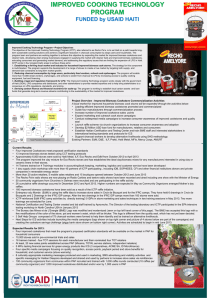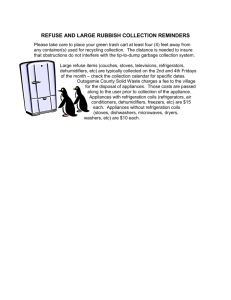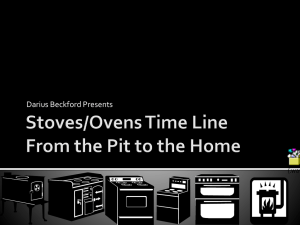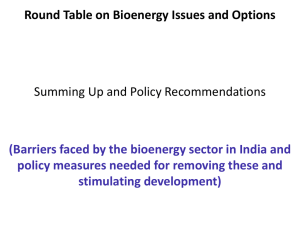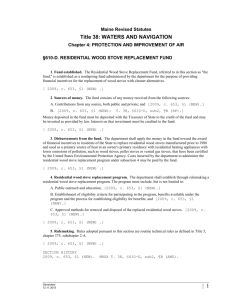II What is a Clean Cookstove? - The Global Efficient Cook Stove
advertisement
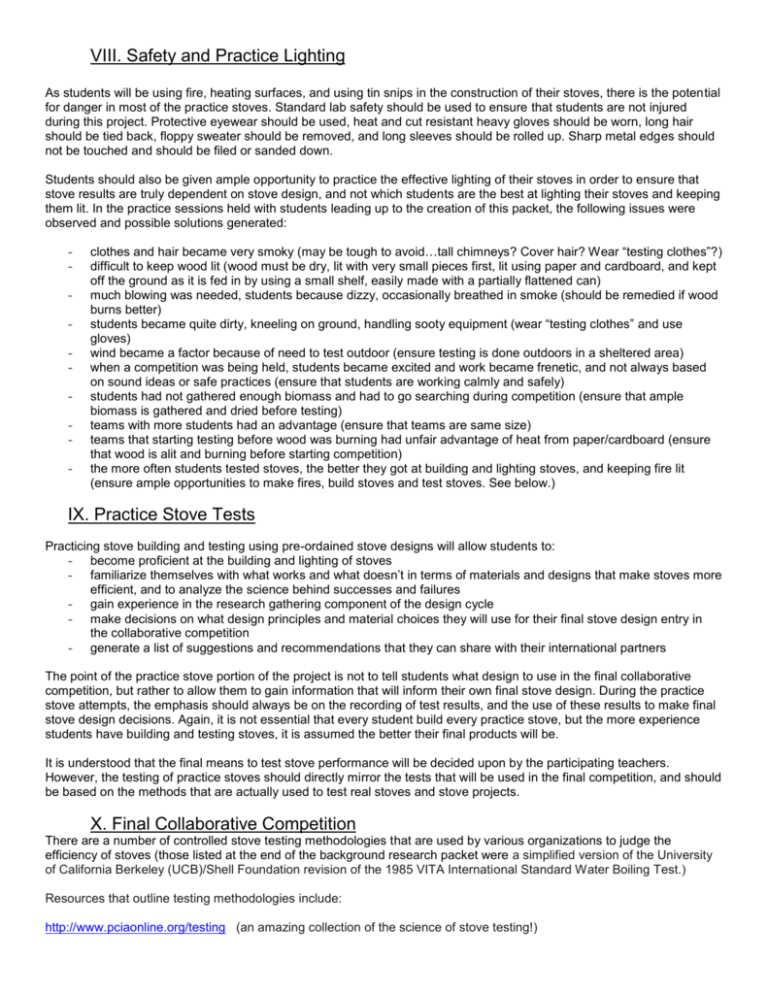
VIII. Safety and Practice Lighting As students will be using fire, heating surfaces, and using tin snips in the construction of their stoves, there is the potential for danger in most of the practice stoves. Standard lab safety should be used to ensure that students are not injured during this project. Protective eyewear should be used, heat and cut resistant heavy gloves should be worn, long hair should be tied back, floppy sweater should be removed, and long sleeves should be rolled up. Sharp metal edges should not be touched and should be filed or sanded down. Students should also be given ample opportunity to practice the effective lighting of their stoves in order to ensure that stove results are truly dependent on stove design, and not which students are the best at lighting their stoves and keeping them lit. In the practice sessions held with students leading up to the creation of this packet, the following issues were observed and possible solutions generated: - clothes and hair became very smoky (may be tough to avoid…tall chimneys? Cover hair? Wear “testing clothes”?) difficult to keep wood lit (wood must be dry, lit with very small pieces first, lit using paper and cardboard, and kept off the ground as it is fed in by using a small shelf, easily made with a partially flattened can) much blowing was needed, students because dizzy, occasionally breathed in smoke (should be remedied if wood burns better) students became quite dirty, kneeling on ground, handling sooty equipment (wear “testing clothes” and use gloves) wind became a factor because of need to test outdoor (ensure testing is done outdoors in a sheltered area) when a competition was being held, students became excited and work became frenetic, and not always based on sound ideas or safe practices (ensure that students are working calmly and safely) students had not gathered enough biomass and had to go searching during competition (ensure that ample biomass is gathered and dried before testing) teams with more students had an advantage (ensure that teams are same size) teams that starting testing before wood was burning had unfair advantage of heat from paper/cardboard (ensure that wood is alit and burning before starting competition) the more often students tested stoves, the better they got at building and lighting stoves, and keeping fire lit (ensure ample opportunities to make fires, build stoves and test stoves. See below.) IX. Practice Stove Tests Practicing stove building and testing using pre-ordained stove designs will allow students to: - become proficient at the building and lighting of stoves - familiarize themselves with what works and what doesn’t in terms of materials and designs that make stoves more efficient, and to analyze the science behind successes and failures - gain experience in the research gathering component of the design cycle - make decisions on what design principles and material choices they will use for their final stove design entry in the collaborative competition - generate a list of suggestions and recommendations that they can share with their international partners The point of the practice stove portion of the project is not to tell students what design to use in the final collaborative competition, but rather to allow them to gain information that will inform their own final stove design. During the practice stove attempts, the emphasis should always be on the recording of test results, and the use of these results to make final stove design decisions. Again, it is not essential that every student build every practice stove, but the more experience students have building and testing stoves, it is assumed the better their final products will be. It is understood that the final means to test stove performance will be decided upon by the participating teachers. However, the testing of practice stoves should directly mirror the tests that will be used in the final competition, and should be based on the methods that are actually used to test real stoves and stove projects. X. Final Collaborative Competition There are a number of controlled stove testing methodologies that are used by various organizations to judge the efficiency of stoves (those listed at the end of the background research packet were a simplified version of the University of California Berkeley (UCB)/Shell Foundation revision of the 1985 VITA International Standard Water Boiling Test.) Resources that outline testing methodologies include: http://www.pciaonline.org/testing (an amazing collection of the science of stove testing!) http://www.rocketstove.org/index.php?option=com_content&task=section&id=11&Itemid=90 http://berkeleyair.com/publications/cat_view/42-publications Typically, testing organizations attempt to determine the efficiency and effectiveness of stoves in a variety of ways. These include: - A Water Boiling Speed Test – As outlined by the PCIA, in general the test consists of three phases. These are: (1) bringing 5L of water to a boil from a cold start; (2) bringing water to a boil when the stove is hot; and, (3) maintaining the water at simmering temperatures. - A Water Boiling Fuel/Energy Use Test – Again, as outlined by the PCIA, this test calculates the amount of fuel and the amount of energy needed to boil water, and often to keep it simmering for 45 minutes. Typically, the mass of wood or charcoal is measured before and after the test. Conversions to kJ of energy used are used to compare stoves that use different types of fuel (wood, charcoal, propane, etc.) - A Controlled Cooking Test – The amount of fuel needed to cook specific, locally determined dishes by local cooks is measured - Particulate Matter (PM) emissions – typically uses probes in a collection hood to measure the amount of PM, one of the leading cause of respiratory diseases in biomass stove users - Carbon Monoxide (CO) emissions – uses probes in a collection hood to measure this poisonous gas - A Test Kitchen Test looks at the quality of air at different locations in an actual kitchen - Safety Tests look at such factors as stability, exposure of heated surface, jagged edges, etc. or anything that could put users or children at risk - Cost – both to purchase/build and to use over time. Once effective test that was used during the development of this project was the use of popcorn to determine heat produced (first kernel popped, first stove to pop all kernels, etc.) This test removed some of the subjectivity of determining when boiling had occurred and provided an element of entertainment to the tests. In our project, participating teachers will conference in order to allow each school to determine the best method to assess efficiency and effectiveness of the stoves built by student. Without a doubt, WBT’s and Fuel Use tests are the standard method for comparing efficiencies and should likely be used in this project. Additionally, the other methodologies listed above may play a role in determining stove quality, particularly if a cheap and effective way of measuring PM and CO can be found. XI. “Going Global” The final piece of the project involves students from each school collaborating to take, what they have learned in their background research, practice stove testing, performance in the final collaborative competition, conversations with authorities, and collaborative work with students in other countries to educate others around the world. There are a number of forms this could take, and could involve such things as posting photos, slide shows, etc. of the various parts of the project, creating Youtube videos to outline the project, creating websites to publicize the project, contacting local, national and international press and organizations to inform them of the project, etc. Conveniently the Taking It Global education (TIGed) portal provides users with many resources to undertake just this sort of “going global” project. Of particular interest is their “Guide To Action” document that is tailor made for this project. Below is the outline of the process advocated by TIGed in order to effectively “provide students withy the direction and support they need to better work towards making the change they want to see in the world.” The Guide to Action includes many helpful recommendations in terms of how to perform such tasks as working with a team, identifying networks, setting goals for projects, creating a group project plan, promoting a project on TIGed, implementing a project, focusing on having a lasting impact, and even lists challenges that students typically face in “taking an issue global” and provides tips for dealing with these challenges. 2. Background Information A. An Overview Of The Efficient Cookstove Movement From: http://cleancookstoves.org/overview/issue/ I. Effects of Use of Traditional Biomass Cookstoves http://cleancookstoves.org/media-coverage/video-cooking-not-killing/ Exposure to smoke from traditional cookstoves and open fires—the primary means of cooking and heating for nearly three billion people in the developing world—causes 2 million premature deaths annually, with women and young children the most affected. Cookstove smoke contributes to a range of chronic illnesses and acute health impacts such as early childhood pneumonia, emphysema, cataracts, lung cancer, bronchitis, cardiovascular disease, and low birth weight. The World Health Organization estimates harmful cookstove smoke to be one of the top five threats to public health in poor, developing countries. Reliance on biomass for cooking and heating increases pressures on local natural resources (e.g., forests, habitat) and forces women and children to spend many hours each week collecting wood. Women and girls also face severe personal security risks as they forage for fuel from refugee camps and in conflict zones. Inefficient cookstoves also contribute to climate change through emissions of greenhouse gases such as carbon dioxide and methane, and aerosols such as black carbon. How do clean cookstoves and other clean cooking solutions save lives, empower women, improve livelihoods, and combat climate change? Save Lives The use of efficient cookstoves can dramatically reduce fuel consumption and exposure to harmful cookstove smoke. Other steps—installing a chimney, opening windows, keeping children away from cooking fires, and drying wood before using it—can also help reduce direct exposure to smoke, but they do little to mitigate the other air quality, forestry, livelihood, or climate impacts of traditional cookstoves. The development of a thriving global clean cookstove industry that is constantly innovating to improve design and performance, while lowering the cost of stoves, is therefore seen as the most sustainable way to tackle this issue. Photo by: Project Gaia Improve Livelihoods More efficient stoves also reduce the time people (usually women and girls) have to spend collecting fuel. In cases where fuel is purchased, the cost of an efficient cookstove can be covered by the savings in fuel within a few months. Cleaner stoves may last for several years, allowing the accumulated fuel savings to be spent on a range of livelihood-enhancing activities (e.g., income-producing enterprises for women, medicine, and school attendance for children). Photo by: Lisa Feldman The reductions in emissions achieved by clean cookstoves can also create revenues from carbon credits. Stove companies can use this revenue in many ways, for example to reduce the stove price (thus making these products more affordable to poorer consumers), or to expand into new markets. More broadly, the entire clean cookstove supply-chain should be a source of economic opportunity and job creation at the local level. In all cases—central massproduction or local production—local business partners will be needed for distribution, sales, and service of stoves, as well as supply of processed fuels, where appropriate. A thriving global industry for clean cooking solutions will provide these benefits on a sustainable basis, providing jobs to many thousands of individuals. The Alliance is particularly interested in creating such local economic opportunities for women. Photo by: Michael Benanav Combat Climate Change Typically, cookstoves in developing country markets cost from a few dollars to $100, with the higher-performing stoves (95% reduction in emissions) generally costing more than those that provide important, but lower benefits (40-50% reduction in emissions). Recent scientific evidence confirms that the greater the emissions reductions, the greater the health benefits. II What is a Clean Cookstove? In a broad sense, global solutions to the health, climate, and other risks caused by the incomplete combustion of biomass in cooking stoves should meet four core criteria: User needs: Solutions must meet the social, resource, income, and behavioral needs of users. Scalability: Solutions must be scalable through markets or other mechanisms. Performance: Solutions must substantially improve technology design and performance relative to baseline conditions and – once industry standards are in place, be able to meet any international standards for performance and safety. Monitoring: Solutions must stand up to rigorous field monitoring and evaluation to demonstrate actual, in-field impacts. Any fire creates some pollution. However, there are many fuels and advanced stoves that – at least in controlled settings – represent much cleaner solutions. These solutions might be thought of as moving along a spectrum, often referred to as the energy ladder. At one end of the spectrum is the use of raw, unprocessed solid fuels (e.g., dung, crop residues, humid wood) in open fires or crude stoves, while at the other end of the spectrum are ultra-clean fuels (e.g., natural gas, electricity, solar) or modern cooking devices like propane stoves. In the middle are a wide range of technologies and fuels of dramatically varying performance, durability, safety, and cost. The Alliance is technology and fuel neutral, but that neutrality must be related to the performance of the solution and its ability to meet established industry standards, as well as an ability to demonstrate broad consumer acceptance to reach significant scale of operations. The Alliance will seek to advance solutions that are as clean and efficient as possible, and will actively pursue intermediate solutions that can bring about real, measurable benefits. Clean Stove Technologies Clean, efficient, durable, safe, and affordable stoves are – along with clean fuels – central to most solutions to the health, environmental, and other risks inherent in cooking with fire. Advanced stoves are much more likely to achieve the more dramatic health and climate benefits that the Alliance seeks, while other so-called “rocket” stoves achieve important, but more modest progress and are therefore best thought of as intermediate solutions. Still other stoves on the market claim to be “improved,” but once tested may offer only very modest benefits. Photo by: Project Gaia Advanced Biomass Stoves There are two primary types of advanced biomass stoves that can achieve high levels of performance: forced air and gasifier stoves, both of which can run on processed or raw biomass. Forced air stoves have a fan powered either by a battery, an external source of electricity, or a thermoelectric device that captures heat from the stove and converts it to electricity. This fan blows high velocity, low volume jets of air into the combustion chamber, which results in much more complete combustion of the fuel. Gasifier stoves force the gases and smoke into flame above the fuel where almost complete combustion then occurs. In a typical gasifier stove a batch of fuel is top lit. When the fuel underneath the flame gets hot the combustible products have to pass through the flame front. In a fan stove the jets of air create the superior mixing of flame, gas, and smoke seen in the Top Lit Updraft (TLUD) gasifier stoves. Photo by: First Energy Health Emissions: Lab tests of advanced biomass and gasifier stoves on the market today indicate the potential to eliminate key emissions by over 80% in all cases, and by as much as 98% for the better performing stoves. New advanced stoves under development today should be able improve on this potential, though substantial questions remain as to the replicability of these figures in actual operating conditions. Advanced stoves that are optimized for and fueled by a processed (uniform) fuel will very likely have much better results in field conditions. Climate Emissions: Lab tests of advanced biomass stoves for climate forcing emissions found that fan stoves reduced net warming impact by nearly 60% and gasifier stoves by about 40%, when CO2eq was considered. If the biomass was considered to be harvested sustainably, fan stoves reduced overall warming impact by about 95% while gasifier stoves reduced warming impact by about two-thirds. These analyses took into account both greenhouse gases and aerosols such as black carbon. Time to Boil: Lab testing indicates that gasifier and fan stoves may reduce time to boil compared to an open fire. Fuel Use: Lab testing of forced air fan stoves demonstrates reduced fuel use (relative to a 3-stone fire) ranging from 37% to 63%. Gasifier stoves also appear to save on fuel use, though generally less than the fan stoves. Rocket Stoves Rocket stoves are defined by an insulated L-shaped combustion chamber that allows for partial combustion of the gases and smoke in a stove, and thus achieve important emission benefits compared to open fires or crude stoves. These stoves can be centrally massproduced products, locally artisanal products, or anything in between. Health Emissions: Lab tests to date show a wide variety in performance of these stoves, even in laboratory settings. The better rocket stoves on the market achieve in these laboratory settings emissions reductions of roughly 70% or more (for carbon monoxide) and over 50% for particles. Few field studies on emissions performance of these stoves have been completed to date, and performance in the field is likely to be highly variable, depending on the stove, the fuel quality and the individual user. Some field studies of the plancha version of these stoves often used in kitchens in Latin America – a raised wood-burning stove with a chimney, typically designed with a flat griddle to make tortillas – can reduce indoor concentrations of key pollutants by twothirds or more. Climate Emissions: Limited lab testing of rocket stoves to date suggests that some of the more mass-produced versions of this stove will reduce net warming impact by nearly 60%. Current rocket stoves may have little to no impact on emissions of black carbon, which is less of a criticism (they were not designed to) than an observation. It is not unlikely that current rocket stoves could be redesigned to lead to important reductions in black carbon emissions. Time to Boil: The study also showed that the rocket stove was able to reduce time to boil. Fuel Use: Fuel use savings vary widely with the type of rocket stove used. Lab tests show that performance can vary from increasing fuel use for poorly designed rocket stoves of high mass, to saving up to 50% of fuel. Limited independent field testing of these stoves has found that several leading rocket stoves do in fact achieve substantial (40% to 50%) reductions in fuel use. Behavioral and Structural Solutions Many behavioral and structural steps can be taken to reduce human exposures to cookstove smoke. These include: Chimneys: Using and maintaining a chimney is always a good idea, since even advanced stoves or clean fuels lead to some combustion by-products that are best ventilated to the outdoors. If less advanced solutions are in place, chimneys can dramatically reduce immediate personal exposures, though they do not reduce the amount of pollution that contributes to poor outdoor air quality. The effectiveness of chimneys depends in large part on maintenance. Cooking Outdoors: Cooking outdoors is another means of minimizing situations of extremely high concentrations of household air pollution. However, for cooks – or babies on their laps or backs – that are hovering immediately over the stove, the immediate exposures while tending the stove may still be significant. Keeping Children Away from Stoves: This is a social intervention to take children off their mother’s laps or backs during the cooking period, and moved out into a cleaner, safer environment. The goal is to reduce exposures for very young children that are the most vulnerable with regard to cookstove smoke. This intervention has no bearing on the mother’s exposure. Ventilation: Adding ventilation to the kitchen via eave spaces or windows can increase the rate at which air circulates through the kitchen and thereby reduces the build-up of smoke in the kitchen. Well-ventilated kitchens may have dramatically lower indoor concentrations of pollution. Each of these solutions will help to alleviate immediate human exposures to smoke from cookstoves, and are thus to be encouraged as much as possible. However, their health impact may not be as great as envisioned if ambient air is heavily polluted, thereby leading to more chronic, if lesser, exposures to poor outdoor air quality. These solutions will also have little or no impact on cookstoves’ climate impacts or fuel use (and thus local environmental impacts such as deforestation).
